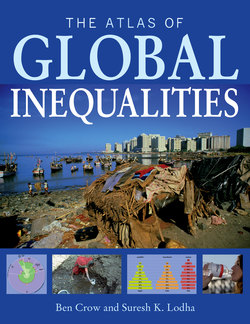Читать книгу The Atlas of Global Inequalities - Ben Crow - Страница 9
На сайте Литреса книга снята с продажи.
ОглавлениеIntroduction
What is inequality? The goal of equality expresses the idea that each person should have comparable freedoms across a range of dimensions. Inequalities are, then, constraints that hinder accomplishment of those freedoms. There is debate about which dimensions of freedom should be prioritized. At the same time, however, there is substantial global common ground that deprivations below a range of achievements constitute unacceptable inequality. This common ground is formulated, most obviously, in the Millennium Development Goals, but also in the Universal Declaration of Human Rights (1948), and in the constitutions of many nations. Another way of answering the question “What is inequality?” comes from sociologist Göran Therborn (2006: 4): inequalities are differences we consider unjust. Humans are diverse, and social conditions across the planet vary, but are raised to the level of injustice – an inequality – when they violate a moral norm and when, as Therborn puts it, the inequality is capable of being changed (2009: 20). When 2 percent of adults possess more than half of all global wealth, when one child in seven dies before the age of five in Sub-Saharan Africa, when one in five girl children is allowed to die young, or is selectively aborted, as happens in China, many consider that unjust. Theories of ethics and justice, from the Left and the Right of the political spectrum, demand equality in one dimension or another in order to speak plausibly to all (Sen 1992). Even theories that argue against equality are concerned with some dimension of inequality. Not only do income-egalitarians … demand equal incomes, and welfare-egalitarians ask for equal welfare levels, but also … pure libertarians demand equality with respect to an entire class of rights and liberties. They are all “egalitarians” in some essential way … (Sen 1992: ix) So, economist and philosopher Amartya Sen argues that ethical and political theories debate not egalitarianism versus freedom, but what dimension of equality should be sought. This atlas broadens the debate from a narrow definition of inequality that focuses on inequality of income because we suspect that specific dimensions of inequality have causes and possible mitigations related to that dimension. Nonetheless, there are some general processes behind a range of inequalities. What causes inequality? While inequalities are often palpable daily experiences for the injured individual, the causes may be multiple and complex. Therborn (2006, 2009) has, nonetheless, suggested a useful fourfold summary of key causes of inequality (which we simplify): Exploitation – the extraction of value by a superior group from an inferior group, for example, employers using low-paid labor; Exclusion – discrimination by one group excluding another, for example, racism; Distantiation – economic mechanisms, such as the bonus
